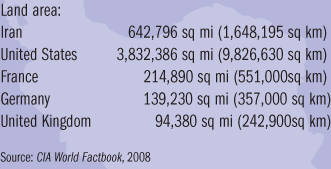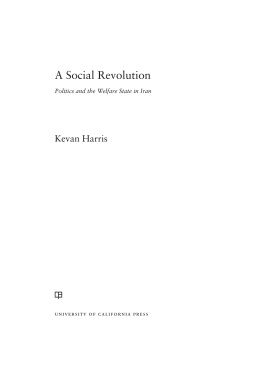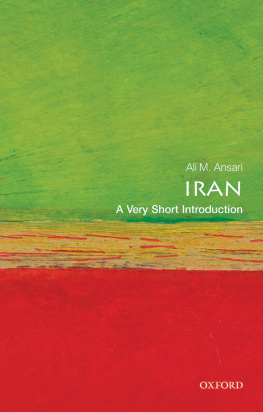
E-book published in 2012 by Encyclopdia Britannica, Inc., in association with Arcturus Publishing Limited, 26/27 Bickels Yard, 151-153 Bermondsey Street, London SE1 3HA. Britannica, Encyclopdia Britannica, and the Thistle logo are registered trademarks of Encyclopdia Britannica, Inc.
ISBN 978-1-61535-636-2 (e-book)
This edition first published by Arcturus Publishing
Distributed by Black Rabbit Books
P.O. Box 3263
Mankato
Minnesota MN 56002
Copyright 2008 Arcturus Publishing Limited
Library of Congress Cataloging-in-Publication Data
Dargie, Richard.
Iran / Richard Dargie.
p. cm. -- (Changing world)
1. Iran--Juvenile literature. I. Title.
DS254.75.D37 2009
955--dc22
2008016657
The right of Richard Dargie to be identified as the author of this work has been asserted by him in accordance with the Copyright, Designs and Patents Act 1988.
All rights reserved.
Series concept: Alex Woolf
Editor and picture researcher: Cath Senker
Designer: Ian Winton
Illustrator: Stefan Chabluk
Picture credits:
Corbis: cover left (Kazyoshi Nomachi), cover right (Kazyoshi Nomachi), 6 (George Steinmetz), 7, 8 (Roger Wood), 11 (Kazyoshi Nomachi), 13, 14 (Arthur Thvenart), 18 (Touhig Sion/Corbis Sygma), 20 (David Turnley), 23 (Abedin Taherkenareh/epa), 37 (George Steinmetz), 39 (Lynsey Addario), 40 (Ceerwan Aziz/Reuters), 41 (Mikhail Klimentiev/epa), 43 (Reuters).
Getty Images: 16 (Time & Life Pictures), 17 (AFP), 25 (AFP), 26, 29 (AFP), 30 (AFP), 33 (AFP), 34 (Scott Peterson).
Shutterstock: 36 (Shelley Shay).
The illustrations on pages 9, 10, 19, 22, 27, 31, and 32 are by Stefan Chabluk.
Cover captions:
Left: Worshippers pray at the shrine of Imam Reza, the eighth Shia imam, in Mashhad, Iran.
Right: The Azadi Tower, built in 1971, marks the entrance to the city of Tehran.
Every attempt has been made to clear copyright. Should there be any inadvertent omission, please apply to the copyright holder for rectification.
Contents
CHAPTER 1
The Land of Iran

I ran is a land of snow-capped mountains, high pasture, and desert plains. For thousands of years, Iran has been home to one of the oldest civilizations in the world. Modern Iranians are proud of their countrys long history and its culture. Today, Iran is a strong regional power that controls one of the most important locations on the globe.
Where is Iran?
Iran lies in the southwestern corner of Asia and is flanked by seven neighbors. To the north, Iran is bordered by Armenia, Azerbaijan, and Turkmenistan. On its western side, Iran shares a frontier with Iraq in the south and with Turkey in the north. Irans eastern neighbors are Pakistan and Afghanistan. Water forms an important part of Irans border. Almost 403 mi (650 km) of Irans northern frontier runs along the shore of the Caspian Sea, while almost all of Irans long southern border is made up of the waters of the Persian Gulf and the Gulf of Oman. Thanks to its size and location, Iran is one of the most important countries in the area known as the Middle East.
COMPARING COUNTRIES: HOW BIG IS IRAN?


The unusual hills and dunes along Irans southeastern coast have been shaped by the baking sun and the monsoon rains. The area here is sparsely populated. Most people in this part of Iran live in a few small fishing villages and ports.

Although covered in snow for much of the year, the summit of Mount Damavand in northern Iran emits steam and volcanic gases such as sulfur dioxide. The ancient Persians believed that a fire-breathing dragon lived within the volcanic peak.
Landscape
Iran is a very mountainous country. The Zagros Mountains cut across western Iran from north to south, reaching heights of over 13,120 ft (4,000 m). The pyramid peak of Mount Damavand rises in the northern chain of the Alborz Mountains above the Caspian coast. At 18,400 ft (5,610 m), this sleeping volcano is one of the highest mountains in Asia.
Broad basins or plateaus lie between the mountain peaks. Much of central Iran is covered by a high plateau that sits at over 2,950 ft (900 m) above sea level. Many of Irans towns and villages have grown up around the more fertile areas in these basins. To the east of the central plateau, however, lie two vast salt deserts, which are largely uninhabited except for a few scattered oases. Here, the dry, stony land is covered with sand and marked with outcrops of salt where the marshes have dried out in the sun.
There is little low-lying land in Iran. However, the small but heavily irrigated Khuzestan plain on Irans western border with Iraq is one of the most fertile areas in the Middle East. There are also smaller plains in the narrow gap between the high Alborz peaks and the waters of the Caspian Sea.
Climate
Iran is an arid or dry land with little rain, although it is more humid along the northern and southern coasts. In the Zagros and Alborz mountains, the winters are bitterly cold, with temperatures often below 32F (0C) and frequent snow on the higher slopes. By high summer, the snow has melted, leaving the bare rock peaks exposed.
In central Iran, summer temperatures can rise from the high 90s to 120F (high 30s and 40s C) Much of the country receives less than 10 inches (25 cm) of rain each year, falling to less than 4 inches (10 cm) in the deserts. In the hotter parts of Iran, the streams and rivers are often seasonal and depend on snowmelt and spring rains from the mountains. In summer, these riverbeds often lie dry for months. Irans largest permanent rivers, such as the Karun, the Karkeh, and the Zayeandeh, mostly flow through the western and southern regions of the country. The wettest parts of Iran lie along the Caspian shore in the north.
CASE STUDY: IRANS SHRINKING LAKE
Over 87 mi (140 km) long and 40 mi (55 km) wide, Lake Urmia is Irans largest lake. Although filled by snowmelt each spring, Urmia has been shrinking for years because of evaporation in the summer heat. Owing to the high salt levels in its water, fish cannot live in the lake, but humans have collected the salt and used it as a medicine for centuries. A causeway across Urmias narrowest point was opened in 2008.

Farm laborers separate grain from the chaff using traditional methods that have changed little in thousands of years. Scenes like this have become rarer as farming in Iran has become more mechanized.

Next page













